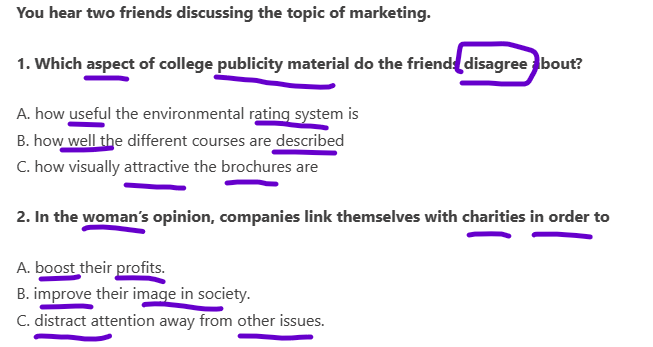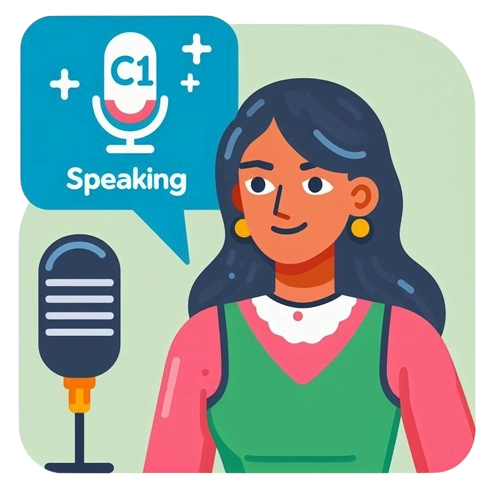Cambridge C1 Advanced (CAE) Listening Part 1
What you will find in this guide:
Introduction
Welcome to the ultimate guide on mastering the “Cambridge C1 Advanced Listening Part 1”. This guide is designed to help you understand the structure and format of the listening part 1 of the Cambridge C1 Advanced Exam, provide you with effective strategies for approaching this section, and offer you practice tests to apply the knowledge you’ve gained12345.
To ace this part of the exam, it’s crucial to develop your listening skills and familiarize yourself with the types of questions you’ll encounter12345. This guide provides you with all the tips and tricks you need to succeed, insights into the listening section, sample questions for practice, and resources for further study12345. By following these strategies and making use of the practice exercises, you’ll be well-prepared for the CAE Listening Part 112345.
Key Takeaways:
Structure of Listening Part 1:
You will get three brief extracts from conversational interactions. The questions include two multiple-choice questions for each extract, making a total of 6 questions.
This part assesses your ability to discern feeling, attitude, opinion, purpose, function, agreement, course of action, gist, and detail.
Potential Challenges:
The accent
Unfamiliar Topics
Vocabulary
Tricky Answer Choices
Inference and Critical Thinking
Steps to Answer Questions:
Read Questions First: Understand what to look for before listening.
Identify Keywords: Focus on keywords in questions and answers.
Listen Carefully: Pay attention to the content of the audio.
Ignore Unfamiliar Words: Do not focus on unknown words; focus on the overall idea.
Focus on Ideas: Answers may be paraphrased; look for the main ideas.
Eliminate Wrong Options: Narrow down choices by eliminating incorrect answers.

Understanding the Format
Let’s dive into the structure and format of the CAE Listening Part 1. This is a crucial part of your preparation, as understanding the format will help you know what to expect and how to approach the questions12345.
The CAE Listening Part 1 consists of three short extracts from conversations, typically between two people35. You’ll listen to each conversation twice, giving you a fair chance to grasp the details25.
For each extract, you’ll find two multiple-choice questions35. These questions are designed to test a variety of listening skills. You’ll need to discern feelings, attitudes, opinions, purposes, functions, agreements, courses of action, gist, and details1. So, it’s not just about understanding the words spoken, but also about understanding the context and the subtext1.
Each question has three options: A, B, or C35. Your task is to select the correct answer based on what you hear35. Remember, each correct answer earns you one mark12345.
In total, there are six questions in this part of the exam35. So, while the format might seem straightforward, don’t underestimate the importance of practice and preparation. Understanding the format is just the first step. The real challenge lies in applying your listening skills effectively to answer the questions correctly12345.
Before I explain how you should do the Cambridge Cl (CAE) listening part 1, let’s take a look at a sample question to see what the questions will look like part 1. So, listen to the sample question down below and try to answer it.
Sample Question
You will hear three different extracts. For questions 1 – 6, choose the answer (A, B or C) which fits best according to what you hear. There are two questions for each extract.
Extract 1
Questions
You hear two friends discussing the topic of marketing.
1. Which aspect of college publicity material do the friends disagree about?
A. how useful the environmental rating system is
B. how well the different courses are described
C. how visually attractive the brochures are
2. In the woman’s opinion, companies link themselves with charities in order to
A. boost their profits.
B. improve their image in society.
C. distract attention away from other issues.
Potential Challenges
As a former examiner and an exam preparation coach of more than a decade, I have seen many candidates struggle with part 1. Some of the most common challenges I have seen candidates battle with are as follows: But remember, every challenge is an opportunity for learning. With the right strategies and consistent practice, you can overcome these challenges and ace the “C1 Advanced Listening Part 1”. As your coach and a former examiner, I’m here to guide you through this journey.
- Accent: You may not be familiar with the accent of the people or one person speaking in the audio as they come from all over the world. To overcome this challenge, you need to expose yourself to listening audio tracks from different parts of the world as much as possible.
- The topics discussed in the audio file: The topics discussed in part 1 are often unfamiliar topics that may sound confusing or give you the feeling that you don’t know anything about the topic. This feeling may distract your attention from the audio and lead to missing some parts of the content you are listening to.
- Vocabulary: Since the topic is not familiar to you, some words used in the audio recording may sound unfamiliar to you, and therefore, you may have trouble understanding the ideas discussed in the listening.
- Answer choices may be tricky: You may find some options tricky, close in meaning, or that they were not mentioned in the audio! This could hinder your ability to find the correct answer, and at times, lead to confusion.
- Inferring and making decision about the correct choice: Most proficiency tests require you to infer from a text you just read or a conversation you just listened to in order to answer a question. This means that you not only need to be proficient in the English language, but also need to have good critical thinking and inference skills.
CAE Listening Part 1: The Ultimate Guide
To make sure that the challenges in part 1 won’t pose a problem to your performance, consider taking the following steps:
Step 1: Read the questions and answer choices before you listen to the extracts. This will give you an idea of what you will be looking for while listening to the extracts. After all, if you don’t know what you’re looking for, how can you focus on it?
Step 2: Identify and underline keywords in the questions and answer choices. This step helps you understand what to focus on and stay on track during the listening exercise.
Step 3: Listen carefully to the information introduced in the audio files (extracts).
Step 4: If you hear an unfamiliar word or something that you don’t understand what it means or what its purpose is, ignore it. Do not try to figure out the meaning of it because if you do, you’ll miss the rest of the information. Remember that you get to listen to each extract twice. So, if you miss something, you’ll have a second chance to listen to that part. Just make sure that you can listen to as much information as possible in each attempt.
Step 5: Focus on the ideas presented in the audio instead of the words and the topic. Keep in mind that the answers may not be presented using the exact words from the questions; instead, they might be paraphrased or provided through synonyms.
Step 6: Now that you have listened to the audio and focused on finding what you are looking for (the ideas in the question), use your logic to decide which answer choices are wrong. Yes, do not start by finding the correct option. Eliminate at least one answer choice that is wrong, then decide what the correct answer is. By eliminating the wrong options, you will increase your chances of success dramatically.
Important Point 1: Listening part 1 is a test, not an enjoyable story. What this means is that you need to listen to the audio tracks only to be able to answer the question, not to enjoy it or to understand every single word (which is nearly impossible by the way). So, it is absolutely normal for you to hear unfamiliar words. When that happens, simply ignore the unfamiliar word and focus on what the speaker is trying to say, not what the word means.
Important Point 2: Pay close attention to the order of the questions, as the information will generally be presented in the same sequence. When listening to the audio, start by focusing on the first question. Then, follow along and move to other questions as you listen. If you miss a piece of information, don’t dwell on it; you’ll have another opportunity to catch it when the audio is replayed. Stay engaged and alert.
Keyword Identification is key!

Practice Test
Use the guide to answer questions for extract 2.
Extract 2
Questions
You hear two friends talking about ways of keeping fit.
3. What is the woman’s criticism of exercising in gyms?
A. Members get limited access to the facilities.
B. The membership cost is too high for the services offered.
C. It encourages exercise habits that lead to unhealthy lifestyles.
4. How does the man respond to his friend’s criticism?
A. He objects to her making sweeping generalizations about gyms.
B. He questions the value of excessive gym attendance.
C. He suspects she’d enjoy a different type of gym.
Extract 3
Questions
You hear a woman telling a friend about living in her capital city as a student.
5. What is she doing during the conversation?
A. admitting to regrets about her choice of place to study.
B. complaining about challenges she’s had to face.
C. expressing her admiration for people in the city.
6. Why does the man give the example of trees?
A. to support her main point.
B. to present a counter-argument to hers.
C. to express a reservation about her interpretation.
References
C1 Advanced exam format | Cambridge English
CAE Listening Paper – exam tips, format & parts | C1 Advanced (CAE) (engxam.com)
CAE Listening Part 1 Multiple choice Technique and Exercises (studentlanguages.com)
Cambridge English: C1 Advanced (CAE) – about the listening part (examenglish.com)
CAE Listening Part 1 + Podcasts for CAE Listening Practice (cisl.edu)
How was your experience?
Describe your experience taking the part 1 listening question in the comment section below.
You may also check out my guides for the other parts of The Cambridge C1 Advanced (CAE) Listening Test:







This pague was very useful to understand what we have to do when we have a listening part, it help me to know clearly on what we have to focus on and what thing to avoid doing while listening.
At the beginning was difficult for mi because of the accents and some words that I didn’t understand, but then with the tips, it became easier, but we really need more practice:
Good exercises to work on in order to improve the listening understanding. In addition to this, the tips given were useful enough to overcome possible issues.
Hi teacher based on my experience it was a great resource to practice listening. Above all the guide que can help us a bit more.
Hi!!
Those tips made my listening a little bit easy, because we need to focus in the things that will be helpful for us. Practice with those advices will help me a lot.